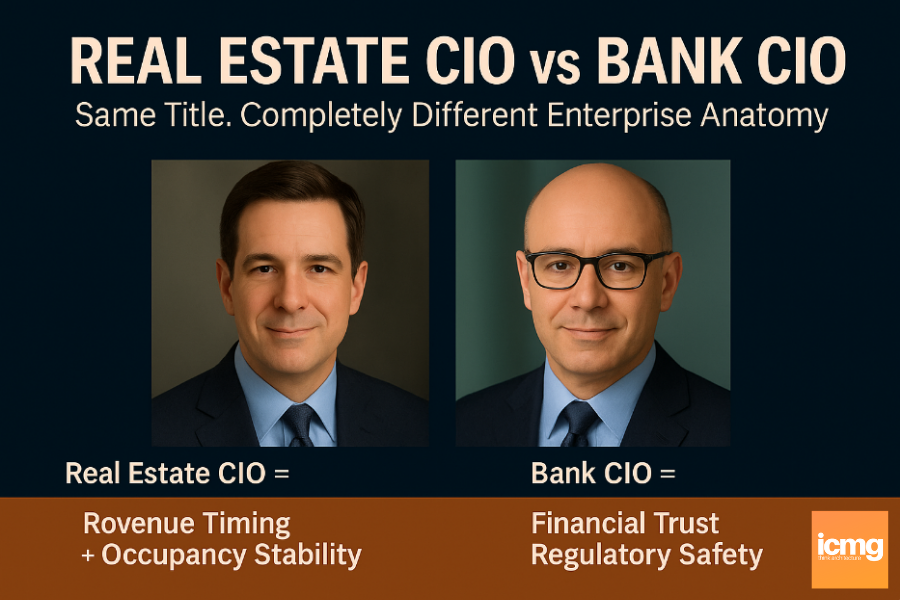Government CIO vs Media CIO. Same Title But Completely Different Enterprise Anatomy™.
- Sunil Dutt Jha

- 2 days ago
- 3 min read
Updated: 8 hours ago

For years, the corporate world assumed a simple equation:
“A CIO is a CIO — and information in all industries are the same.”
But once you step inside the enterprise, the illusion collapses immediately. A Government CIO and a Media CIO might share the same three-letter title, yet their enterprise anatomy, daily pressures, logic structures, and operational realities are completely different.
If you ever needed proof that CIO ≠ IT, and CIO ≠ the same across industries, this comparison makes it unmistakably clear.
1. Core Mission — What Their Enterprise Expects From Them
Every CIO is shaped by the mission their industry demands. And these missions could not be more different.
Government CIO
Responsible for the smooth delivery of public services with fairness, transparency, and compliance.
Their world relies on policy → service → citizen alignment and the protection of data sovereignty, auditability, and national security.
Media CIO
Focused on enabling the entire content lifecycle — from creation to distribution to monetization. Their success depends on production efficiency, accurate rights management, and the integrity of royalties, streaming, and advertising flows.
One mission is built on public trust.The other is built on content velocity and monetization windows.
2. Daily Operational Focus — What They Actually Run
When you look beneath the job title, the day-to-day systems tell the real story.
Government CIO Runs:
Case management systems
Licensing & benefits workflows
Inter-department data exchange
Citizen self-service portals
Grievance and escalation loops
Media CIO Runs:
Multi-platform distribution (OTT, broadcast, social)
Editorial & production scheduling
Rights metadata, contracts, royalties
CDN & streaming quality
Ad-tech & promo workflows
Content lifecycle from creation to archive
These are not variations of the same job. These are two different operational universes.
3. Architecture Pressure Points — Where the Enterprise Breaks
Every CIO navigates drift — but drift looks completely different in each sector.
Government CIO Faces:
Policy interpretation → system logic conflicts
Approval steps that break process flows
Legacy national registries & ID systems
Timing pressure from compliance cycles
Cross-agency interoperability challenges
Media CIO Faces:
Content ingestion → rights → distribution mismatches
Breaks between production, edit, and promo workflows
Fragmented metadata models
Multi-channel output complexity
Real-time streaming operations
Policy drift vs metadata drift. Workflow breaks vs distribution breaks.Compliance timing vs monetization timing.
These pressures shape the entire architecture mandate.
4. What Failure Looks Like
The consequences of drift are industry-specific — and very visible.
Government CIO Failure Means:
Citizen service delays
Benefit or payment disruption
Policy misinterpretation at scale
Loss of compliance
Public frustration and backlash
Media CIO Failure Means:
Show launch delays
Rights violations
Broken monetization windows
Streaming outages
Revenue leakage in ads, syndication, or royalties
Both feel the pressure — but for completely different reasons.
5. What Success Looks Like
When the architecture holds, the outcomes reflect clarity and stability.
Government CIO Success:
Seamless end-to-end service delivery
Zero-break compliance
Traceability of every action
Reduction in manual touchpoints
Faster approvals and benefits
Media CIO Success:
Smooth production-to-publish cycles
High streaming uptime
Accurate royalties and rights logic
Faster promo turnaround
Higher content monetization
Again, worlds apart.
6. Why They Look Nothing Alike — Enterprise Anatomy™ Makes It Obvious
If you trace each role through the P1–P6 lenses of ICMG Enterprise Anatomy™, the difference becomes structural, not semantic.
Perspective (P1–P6) | Government CIO | Media CIO |
P1 – Strategy | Policy → Service Outcomes | Content → Engagement → Revenue |
P2 – Process | Cases, approvals, public workflows | Production, edits, promo, distribution |
P3 – Logic | Eligibility, compliance, workflows | Rights, metadata, syndication |
P4 – Components | Registries, ID databases, forms | CMS, MAM, ad-tech, CDN configs |
P5 – Tasks | Agency IT + vendor coordination | Studio ops + digital teams |
P6 – Operations | Citizen ops, field officers | Streams, feeds, scheduling |
Two roles. Two anatomies. Zero overlap — except the title.
The CIO role is not defined by IT systems. It is defined by the enterprise’s anatomy — and every industry expresses that anatomy differently.
The Real Insight
The myth that “CIOs are interchangeable” comes from a shallow understanding of the enterprise. Once you diagnose the actual structural flows, the difference becomes unmistakable.
Government CIO = Public Service Integrity
Media CIO = Content Monetization Engine
Both essential. Both powerful. Both completely different anatomies.


